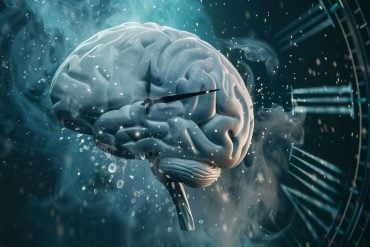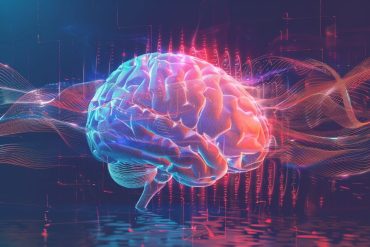Summary: Researchers discovered that a specific brain region, the mediodorsal thalamus, may provoke feelings of paranoia. By aligning data from studies on monkeys and humans, they found that lesions in this brain region led to erratic behavior and increased perceptions of environmental volatility.
The study offers a new framework for understanding human cognition through cross-species research. These findings could pave the way for developing targeted treatments for paranoia and other cognitive issues.
Key Facts:
- The study focused on the orbitofrontal cortex and mediodorsal thalamus.
- Lesions in these areas caused different erratic behaviors in monkeys.
- High paranoia in humans mirrored volatile perceptions in monkeys.
Source: Yale
The capacity to adjust beliefs about one’s actions and their consequences in a constantly changing environment is a defining characteristic of advanced cognition. Disruptions to this ability, however, can negatively affect cognition and behavior, leading to such states of mind as paranoia, or the belief that others intend to harm us.
In a new study, Yale scientists uncover how one specific region of the brain might causally provoke these feelings of paranoia.
Their novel approach — which involved aligning data collected from monkeys with human data — also offers a new cross-species framework through which scientists might better understand human cognition through the study of other species.

Their findings, and the approach they used, are described June 13 in the journal Cell Reports.
While past studies have implicated some brain regions in paranoia, the understanding of paranoia’s neural underpinnings remains limited.
For the new study, the Yale researchers analyzed existing data from previous studies, conducted by multiple labs, on both humans and monkeys.
In all of the previous studies, humans and monkeys performed the same task, which captures how volatile, or how unstable, a participant believes their environment to be. Participants in each study were given three options on a screen, which were associated with different probabilities of receiving a reward.
If the participants selected the option with the highest probability of reward, they would get a reward with fewer clicks across trials. The option with the lowest probability required more clicks to receive a reward.
The third option, meanwhile, was somewhere in the middle. Participants did not have information on the reward probability and had to uncover their best option by trial and error.
After a set number of trials and without warning, the highest and lowest reward probability options flip.
“So participants have to figure out what’s the best target, and when there’s a perceived change in the environment, the participant then has to find the new best target,” said Steve Chang, associate professor of psychology and of neuroscience in Yale’s Faculty of Arts and Sciences and co-senior author of the study.
Participants’ clicking behavior before and after the flip could reveal information about how volatile they view their environment to be and how adaptive their behavior is within that changing environment.
“Not only did we use data in which monkeys and humans performed the same task, we also applied the same computational analysis to both datasets,” said Philip Corlett, an associate professor of psychiatry at Yale School of Medicine and co-senior author of the study.
“The computational model is essentially a series of equations that we can use to try to explain the behavior, and here it serves as the common language between the human and monkey data and allows us to compare the two and see how the monkey data relates to the human data.”
In the previous studies, some of the monkeys had small but specific lesions in one of two brain regions of interest: the orbitofrontal cortex, which has been associated with reward-related decision-making, or the mediodorsal thalamus, which sends environmental information to the decision-making control centers of the brain.
Among human participants, some had reported high paranoia and some did not.
The researchers found that the presence of lesions in both brain regions negatively affected the behavior of the monkeys, but in different ways.
Monkeys with lesions in the orbitofrontal cortex more often stuck with the same options even after not receiving a reward. Those with lesions in the mediodorsal thalamus, on the other hand, displayed erratic switching behavior, even after receiving reward.
They appeared to perceive their environments as especially volatile, which was similar to what the researchers observed in the human participants with high paranoia.
The findings offer new information about what is happening in the human brain — and the role the mediodorsal thalamus might play — when people experience paranoia, say the researchers. And they provide a pathway for how to study complex human behaviors in simpler animals.
“It allows us to ask how we can translate what we learn in simpler species — like rats, mice, maybe even invertebrates — to understand human cognition,” said Corlett, who, along with Chang, is a member of Yale’s Wu Tsai Institute, which aims to accelerate understanding of human cognition.
This approach will also allow researchers to assess how pharmaceutical treatments that affect states like paranoia actually work in the brain.
“And maybe down the road we can use it to find new ways to reduce paranoia in humans,” said Chang.
The work was led by co-first authors Praveen Suthaharan, a graduate student in Corlett’s lab, and Summer Thompson, an associate research scientist in Yale’s Department of Psychiatry. It was done in collaboration with Jane Taylor, the Charles B.G. Murphy Professor of Psychiatry at Yale School of Medicine.
About this neuroscience and paranoia research news
Author: Fred Mamoun
Source: Yale
Contact: Fred Mamoun – Yale
Image: The image is credited to Neuroscience News
Original Research: Open access.
“Lesions to the mediodorsal thalamus, but not orbitofrontal cortex, enhance volatility beliefs linked to paranoia” by Steve Chang et al. Cell Reports
Abstract
Lesions to the mediodorsal thalamus, but not orbitofrontal cortex, enhance volatility beliefs linked to paranoia
Beliefs—attitudes toward some state of the environment—guide action selection and should be robust to variability but sensitive to meaningful change.
Beliefs about volatility (expectation of change) are associated with paranoia in humans, but the brain regions responsible for volatility beliefs remain unknown.
The orbitofrontal cortex (OFC) is central to adaptive behavior, whereas the magnocellular mediodorsal thalamus (MDmc) is essential for arbitrating between perceptions and action policies.
We assessed belief updating in a three-choice probabilistic reversal learning task following excitotoxic lesions of the MDmc (n = 3) or OFC (n = 3) and compared performance with that of unoperated monkeys (n = 14).
Computational analyses indicated a double dissociation: MDmc, but not OFC, lesions were associated with erratic switching behavior and heightened volatility belief (as in paranoia in humans), whereas OFC, but not MDmc, lesions were associated with increased lose-stay behavior and reward learning rates.
Given the consilience across species and models, these results have implications for understanding paranoia.






